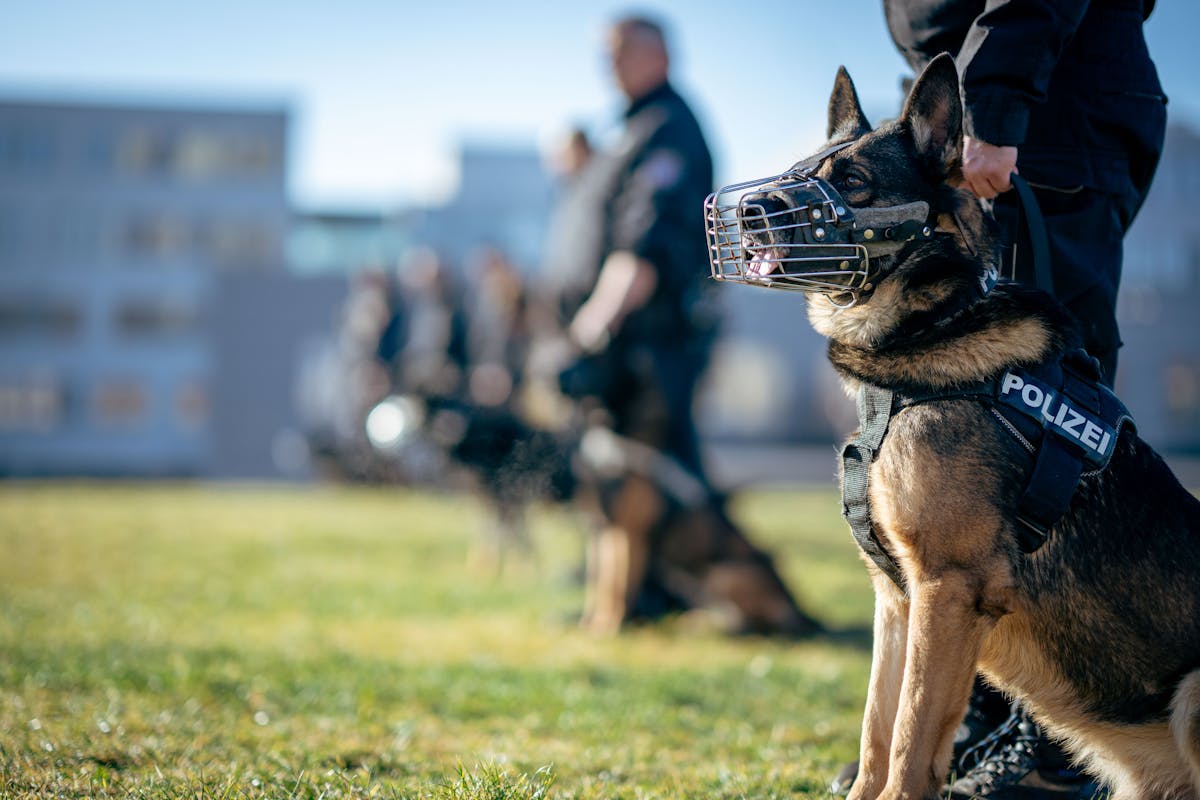What Rules Does Texas Have About Police Dogs and Drug Charges?

The utilization of police dogs in Texas, specifically in drug-related cases, is governed by a complex set of rules and regulations that intersect the state’s drug laws and Fourth Amendment rights. These rules, which dictate the conditions under which a canine-assisted search is deemed legal and the weight of a dog’s indication in the court of law, raise intriguing questions about the balance between effective law enforcement and the protection of individual rights. As we examine these laws more closely, we are presented with an opportunity to evaluate their implications on the broader landscape of drug enforcement in Texas.
Understanding Texas Drug Laws
Steering through the intricate maze of Texas drug laws, it becomes evident that these regulations are both strict and comprehensive. These laws, forming the backbone of the state’s drug policy, cover a vast array of substances from marijuana to prescription drugs and methamphetamines.
A detailed examination of the Texas Health and Safety Code exposes the severity of penalties associated with drug offenses. The legal implications depend on several factors such as the type and amount of the drug, the intent of possession, and the offender’s previous convictions. For instance, possession of less than one gram of a Penalty Group 1 substance like cocaine can lead to a state jail felony, punishable by up to two years in jail and a fine of up to $10,000.
The policy’s comprehensiveness is evident in its meticulous categorization of drugs into penalty groups, each with distinct punishments. This approach, while complex, underscores the state’s commitment to addressing the drug problem holistically, treating recreational drug use, prescription drug abuse, and trafficking with equal gravity. Understanding these laws is essential for anyone maneuvering through the legal system in Texas, with or without a police dog’s involvement.
Role of Police Dogs in Enforcement
Canine units, often known as K-9 units, play an integral role in the enforcement of Texas drug laws. These specialized dogs are trained specifically to identify and alert authorities to the presence of narcotics, thereby aiding in the apprehension of those involved in drug trafficking and usage.
The effectiveness of K-9 units largely hinges on their acute olfactory senses and their ability to discern specific scents associated with different types of drugs. This ability, combined with their inherent canine behavior, allows them to effectively search vehicles, buildings, and open spaces for hidden narcotics.
Significantly, the detection accuracy of these dogs has been a central point of discussion. While some studies suggest that K-9 units can identify drugs with a high degree of precision, questions have been raised about potential false-positive results. Factors such as handler bias, environmental conditions, and the presence of residual odors can, at times, influence the accuracy of a dog’s detection abilities.
Nonetheless, the use of police dogs in enforcing Texas drug laws remains a crucial tool in the fight against drug-related crimes, underscoring the importance of maintaining and refining the standards of their training and utilization.
Training Standards for Narcotic Detection Dogs
In the domain of law enforcement, the stringent training standards for narcotic detection dogs are vital to secure their ideal performance in the field. These canines, often known as K-9 units, undergo meticulous training procedures to enhance their natural scent-detection abilities and to guarantee their reactions are reliable and consistent.
The Texas Commission on Law Enforcement (TCOLE) mandates that both the handler and the dog must achieve certification together. This handler certification process involves rigorous training sessions and an in-depth understanding of dog behavior. Handlers need to identify subtle signals from their dogs that indicate the presence of narcotics.
An important aspect of the training is fostering a strong bond between the handler and the dog. This relationship is vital for effective communication and efficient action in the field. The dogs are trained to react passively when they detect narcotics, usually by sitting or pointing their nose towards the item.
Continuous training is necessary even after certification, to maintain the dog’s skills and handler’s competence. This commitment to rigorous training standards guarantees that Texas’s narcotic detection dogs are some of the most reliable resources in the fight against drug-related crimes.
Legality of Canine-Assisted Searches
The legality of canine-assisted searches in Texas presents a complex intersection between law enforcement practices and civil liberties. In order to fully grasp its implications, we must examine the current Texas legislation governing these searches and the potential impact on drug charges. This exploration is essential in understanding how these procedures align or conflict with constitutional rights and the fairness of subsequent legal proceedings.
Texas Canine-Search Legislation
Delving into the domain of legality surrounding canine-assisted searches in Texas, it becomes clear that the regulations governing this practice are both complex and nuanced. The Texas Canine-Search Legislation is deeply rooted in Fourth Amendment rights, which protect citizens from unreasonable searches and seizures.
The roles of police dogs in Texas are primarily defined by search protocols. These dogs are trained to detect specific substances, including narcotics. However, canine rights are also taken into account. The use of police dogs must not involve any form of cruelty or abuse.
In terms of legislation, the Texas Penal Code specifies that an officer must have reasonable suspicion or probable cause to conduct a canine-assisted search. This guarantees the legality of the search and protects the rights of the individual. Additionally, the U.S. Supreme Court also recognizes the role of police dogs in lawful searches, but emphasizes that they must be used responsibly and ethically.
The Texas Canine-Search Legislation is a delicate balance of maintaining law and order, protecting individual rights, and guaranteeing the ethical treatment of police dogs. It is essential for law enforcement officials to understand and respect these regulations to guarantee the legality of their actions.

Drug Charges Implications
Maneuvering the legal implications of drug charges in Texas, especially those involving canine-assisted searches, requires an extensive understanding of both state and federal laws. The Fourth Amendment of the U.S. Constitution protects citizens from unreasonable searches and seizures. This constitutional protection extends to drug detection by police dogs.
The crux of the issue lies in determining what constitutes a reasonable search. In Texas, a canine-assisted search is generally considered reasonable if law enforcement has a legitimate suspicion of illegal activity. However, the court will scrutinize the basis of this suspicion, often questioning the canine reliability.
The reliability of the dog’s performance in drug detection plays a pivotal role in the court’s decision. Factors such as the dog’s training, certification, and success rate in identifying drugs can considerably impact the legitimacy of the search. In instances where the dog’s reliability is questionable, the evidence procured through the search may be deemed inadmissible.
Furthermore, the Texas Court of Criminal Appeals ruled that the dog sniff is considered a search under Texas law. Consequently, a warrant might be required in certain circumstances. Maneuvering these legal intricacies underlines the importance of competent legal representation in cases involving drug charges and canine-assisted searches.
Impact of Dog Indications on Charges
The role of canine signals in arrests noticeably affects the ensuing charges, shaping the trajectory of the legal proceedings. The validity of evidence obtained through dog-induced searches becomes a pivotal point of contention in courtrooms. To comprehend the full implications of this, we must carefully examine both the patterns of these indications and the subsequent legal ramifications.
Canine Signals in Arrests
Texas law enforcement’s reliance on canine signals may considerably impact the progression and outcome of drug-related arrests. This dependence stems from the exceptional olfactory abilities that dogs possess, enabling them to detect illicit substances that would otherwise be difficult for a human to discover.
An important aspect in this situation is canine behavior. Police dogs are trained to exhibit specific actions, such as scratching, sitting, or pointing their nose when they detect drugs. These behaviors serve as a strong signal for officers to conduct a more thorough search and can lead to an arrest if illicit substances are found.
However, the handler’s influence can potentially skew these signals. The handler’s conscious or unconscious cues may inadvertently prompt the dog to exhibit the alert behavior, even when no drugs are present. This phenomenon, known as “cueing”, can lead to false positives, resulting in unwarranted arrests and potential legal complications.
Given these factors, the role of canine signals in Texas drug arrests is multifaceted. While dogs’ heightened sense of smell can be instrumental in identifying drug offenders, the potential for handler-induced errors underlines the complexity of their use in law enforcement. Balanced training for both dogs and handlers is therefore essential to guarantee the integrity of this process.
Dog-Induced Evidence Validity
A significant percentage of drug arrests in the Lone Star State hinge on the reliability of the evidence induced by police dogs. This canine-aided police work can be incredibly effective, but concerns over dog behavior and the validity of their indications have raised questions about the legal precedent surrounding such arrests.
In evaluating the reliability of dog-induced evidence, courts closely scrutinize the dog’s behavior at the scene. Factors such as the dog’s training, its handler’s expertise, and the specific circumstances surrounding the detection can play a significant role. It’s crucial to recognize that the dog’s indication alone is generally not enough to establish probable cause for an arrest. Instead, it should be corroborated by other evidence or suspicious circumstances.
The legal precedent in Texas leans towards accepting the indication of a well-trained police dog as a legitimate part of the probable cause in drug charges. However, it is not an absolute rule. Cases where the dog’s behavior or handler’s interpretation was proven unreliable can result in the dismissal of charges. Hence, the validity of dog-induced evidence remains a dynamic aspect of Texas drug law enforcement.
Controversies Surrounding Drug-Sniffing Dogs
Dogged by controversy, drug-sniffing dogs utilized by Texas law enforcement agencies are at the center of numerous debates. The primary concern is the high number of false positives, where dogs indicate the presence of drugs where none exist. Such false alerts can lead to unwarranted searches, violating an individual’s Fourth Amendment rights.
Investigative reports have revealed that dog biases might play a significant role in these false detections. Dogs, by their very nature, are keen to please their handlers. If the handler, consciously or subconsciously, expects or wants the dog to alert, the dog is likely to do so, regardless of the presence of drugs. This phenomenon, known as the Clever Hans effect, has been studied extensively and underscores the potential for misuse.
Moreover, some critics argue that the use of drug-sniffing dogs disproportionately targets certain communities, adding another layer of controversy. In response, law enforcement agencies maintain that these canines are an essential tool in their drug enforcement strategies. The debate continues, highlighting the need for rigorous, unbiased testing and training protocols for these four-legged officers.
Practical Tips for Encounters With Police Dogs
Should you find yourself in a situation involving a drug-sniffing police dog, it is paramount to understand how to effectively navigate this encounter. Key encounter strategies include remaining calm and non-confrontational, as sudden movements or aggressive behavior might be perceived as a threat, potentially leading to an escalation of the situation.
Understanding dog behavior can also be beneficial. Police dogs are highly trained and are particularly sensitive to changes in human demeanor and actions, which they are taught to interpret as indicators of potential illegal activity. They may react to nervousness or fear, so maintaining a steady, neutral demeanor is advisable.
Moreover, it is essential to follow the instructions given by the police officer handling the dog. Any attempt to interfere with the dog’s operation, such as petting or feeding, could be construed as obstruction of justice.
Lastly, remember your rights. While police dogs can sniff your vehicle or person in public areas, a search warrant is typically required for more invasive searches. It’s important to politely but firmly insist on your legal protections if you believe they are being violated.
These strategies can help mitigate potential issues during such encounters.
Frequently Asked Questions
What Breeds Are Commonly Used as Police Dogs in Texas?
In Texas, breeds commonly utilized as police dogs include German Shepherds, Belgian Malinois, and Labrador Retrievers, due to their intelligence, trainability, and proven effectiveness in detection and enforcement tasks. Dog training techniques vary by breed and task.
How Long Does a Police Dog Typically Serve Before Retirement?
In Texas, the service duration for a police dog typically spans between 6-9 years, contingent on its health and performance. The retirement process is initiated once the dog’s training duration and service efficiency begin to wane.
What Happens to Retired Police Dogs in Texas?
In Texas, retired police dogs typically enjoy retirement benefits such as ongoing health care. They are often adopted by their handlers or other responsible families, ensuring a safe and comfortable life post active-duty.
Are There Special Protections or Penalties for Harming a Police Dog in Texas?
In Texas, both federal and state laws provide protections for police dogs. Harms inflicted on these dogs incur severe penalties, such as felony charges, fines, and potential prison sentences, to deter and punish such actions.
Do Police Dogs Reside With Their Handlers in Texas?
In Texas, police dogs typically reside with their handlers, reflecting a common practice nationwide. This facilitates bonding and helps maintain rigorous training schedules, essential for their role in law enforcement. Handler responsibilities indeed involve thorough care for these dogs.


